Unnecessary Endoscopies Could Be Avoided with Fecal Blood Test
|
By LabMedica International staff writers Posted on 14 Oct 2016 |

Image: The Quantum Blue rapid test allow for the immediate measurement of fecal calprotectin (Photo courtesy of Bühlmann Laboratories).
The majority of primary care patients referred for bowel endoscopy do not have significant colorectal disease (SCD), and are unnecessarily exposed to a small but realistic risk of severe endoscopy-associated complications.
Serious colorectal diseases, including colorectal cancer, are difficult to diagnose as the signs and symptoms are not always clear. Any suspicion of SCD requires a general practitioner referral to a hospital for an endoscopy but studies have shown that between 60% to 80% of referred patients end up not having SCD.
Scientists at the University Medical Center Utrecht (Netherlands) collected data from the large-scale study where 810 patients suspected of SCD were enrolled from 266 primary care practices in the Netherlands. A pre-endoscopy venous blood sample was drawn to estimate hemoglobin and C-reactive protein (CRP) concentrations according to routine clinical practice. The team developed a diagnostic strategy to better exclude SCD in these patients and evaluated the value of adding a fecal calprotectin point-of-care (POC) and/or a POC fecal immunochemical test for hemoglobin (FIT-Hb)) to routine clinical information.
The investigators analyzed the fecal samples for calprotectin concentration by a quantitative point-of-care (POC) test (Quantum Blue; dynamic range 30 to 300 μg/g) and by an enzyme-linked immunosorbent assay (ELISA; EK-CAL Calprotectin ELISA, (both from Bühlmann Laboratories, Schönenbuch, Switzerland), both yielding estimates of μg calprotectin/g feces. For fecal Hb the team used a qualitative POC FIT, the Clearview iFOBT One Step Fecal Occult Blood Test Device, (Alere Health; Waltham, MA, USA), yielding either a positive or negative test result with a lower detection limit of 6 μg/g.
Out of the 810 patients referred for an endoscopy, 669 were found to have no SCD. Once the results of the FIT test had been taken into account the scientists found that approximately 30% of these patients could have been prevented from having an endoscopy as they may have been correctly diagnosed as not having SCD during their doctor’s visit. The study also looked at the benefit of adding a fecal test for the protein calprotectin to the diagnostic strategy. They found that this test also improved the diagnosis of SCD but not to the same extent as FIT. Furthermore, combining both tests added little extra benefit to the diagnostic accuracy of FIT alone.
The authors concluded that FIT and to a much lesser extent calprotectin POC testing showed incremental value for SCD diagnosis beyond standard clinical information. A diagnostic strategy with routine clinical data and a POC FIT test may safely rule out SCD and prevent unnecessary endoscopy referral in approximately one third of SCD-suspected primary care patients. The study was published on September 26, 2016, in the journal BMC Medicine.
Related Links:
University Medical Center Utrecht
Bühlmann Laboratories
Alere Health
Serious colorectal diseases, including colorectal cancer, are difficult to diagnose as the signs and symptoms are not always clear. Any suspicion of SCD requires a general practitioner referral to a hospital for an endoscopy but studies have shown that between 60% to 80% of referred patients end up not having SCD.
Scientists at the University Medical Center Utrecht (Netherlands) collected data from the large-scale study where 810 patients suspected of SCD were enrolled from 266 primary care practices in the Netherlands. A pre-endoscopy venous blood sample was drawn to estimate hemoglobin and C-reactive protein (CRP) concentrations according to routine clinical practice. The team developed a diagnostic strategy to better exclude SCD in these patients and evaluated the value of adding a fecal calprotectin point-of-care (POC) and/or a POC fecal immunochemical test for hemoglobin (FIT-Hb)) to routine clinical information.
The investigators analyzed the fecal samples for calprotectin concentration by a quantitative point-of-care (POC) test (Quantum Blue; dynamic range 30 to 300 μg/g) and by an enzyme-linked immunosorbent assay (ELISA; EK-CAL Calprotectin ELISA, (both from Bühlmann Laboratories, Schönenbuch, Switzerland), both yielding estimates of μg calprotectin/g feces. For fecal Hb the team used a qualitative POC FIT, the Clearview iFOBT One Step Fecal Occult Blood Test Device, (Alere Health; Waltham, MA, USA), yielding either a positive or negative test result with a lower detection limit of 6 μg/g.
Out of the 810 patients referred for an endoscopy, 669 were found to have no SCD. Once the results of the FIT test had been taken into account the scientists found that approximately 30% of these patients could have been prevented from having an endoscopy as they may have been correctly diagnosed as not having SCD during their doctor’s visit. The study also looked at the benefit of adding a fecal test for the protein calprotectin to the diagnostic strategy. They found that this test also improved the diagnosis of SCD but not to the same extent as FIT. Furthermore, combining both tests added little extra benefit to the diagnostic accuracy of FIT alone.
The authors concluded that FIT and to a much lesser extent calprotectin POC testing showed incremental value for SCD diagnosis beyond standard clinical information. A diagnostic strategy with routine clinical data and a POC FIT test may safely rule out SCD and prevent unnecessary endoscopy referral in approximately one third of SCD-suspected primary care patients. The study was published on September 26, 2016, in the journal BMC Medicine.
Related Links:
University Medical Center Utrecht
Bühlmann Laboratories
Alere Health
Latest Pathology News
- AI-Powered Label-Free Optical Imaging Accurately Identifies Thyroid Cancer During Surgery
- Deep Learning–Based Method Improves Cancer Diagnosis
- ADLM Updates Expert Guidance on Urine Drug Testing for Patients in Emergency Departments
- New Age-Based Blood Test Thresholds to Catch Ovarian Cancer Earlier
- Genetics and AI Improve Diagnosis of Aortic Stenosis
- AI Tool Simultaneously Identifies Genetic Mutations and Disease Type
- Rapid Low-Cost Tests Can Prevent Child Deaths from Contaminated Medicinal Syrups
- Tumor Signals in Saliva and Blood Enable Non-Invasive Monitoring of Head and Neck Cancer
- Common Health Issues Can Influence New Blood Tests for Alzheimer’s Disease
- Blood Test Formula Identifies Chronic Liver Disease Patients with Higher Cancer Risk
- Tunable Cell-Sorting Device Holds Potential for Multiple Biomedical Applications
- AI Tool Outperforms Doctors in Spotting Blood Cell Abnormalities
- AI Tool Rapidly Analyzes Complex Cancer Images for Personalized Treatment
- Diagnostic Technology Performs Rapid Biofluid Analysis Using Single Droplet
- Novel Technology Tracks Hidden Cancer Cells Faster
- AI Tool Improves Breast Cancer Detection
Channels
Molecular Diagnostics
view channel
Genetic Testing Identifies CHIP Patients at Increased Heart Disease Risk After Cancer Treatment
Genetic testing in cancer care often reveals unexpected findings that are not directly related to the tumor itself. One such finding is clonal hematopoiesis of indeterminate potential, a condition caused... Read more
Advances in Liquid Biopsies Improve Detection of Lung Cancer Mutations
Lung cancer remains one of the deadliest cancers, largely because diagnosis often occurs at an advanced stage when treatment options are limited. In non-small cell lung cancer (NSCLC), identifying genetic... Read moreHematology
view channel
MRD Tests Could Predict Survival in Leukemia Patients
Acute myeloid leukemia is an aggressive blood cancer that disrupts normal blood cell production and often relapses even after intensive treatment. Clinicians currently lack early, reliable markers to predict... Read more
Platelet Activity Blood Test in Middle Age Could Identify Early Alzheimer’s Risk
Early detection of Alzheimer’s disease remains one of the biggest unmet needs in neurology, particularly because the biological changes underlying the disorder begin decades before memory symptoms appear.... Read more
Microvesicles Measurement Could Detect Vascular Injury in Sickle Cell Disease Patients
Assessing disease severity in sickle cell disease (SCD) remains challenging, especially when trying to predict hemolysis, vascular injury, and risk of complications such as vaso-occlusive crises.... Read more
ADLM’s New Coagulation Testing Guidance to Improve Care for Patients on Blood Thinners
Direct oral anticoagulants (DOACs) are one of the most common types of blood thinners. Patients take them to prevent a host of complications that could arise from blood clotting, including stroke, deep... Read moreImmunology
view channel
Ultrasensitive Liquid Biopsy Demonstrates Efficacy in Predicting Immunotherapy Response
Immunotherapy has transformed cancer treatment, but only a small proportion of patients experience lasting benefit, with response rates often remaining between 10% and 20%. Clinicians currently lack reliable... Read more
Blood Test Could Identify Colon Cancer Patients to Benefit from NSAIDs
Colon cancer remains a major cause of cancer-related illness, with many patients facing relapse even after surgery and chemotherapy. Up to 40% of people with stage III disease experience recurrence, highlighting... Read moreMicrobiology
view channel
New Test Measures How Effectively Antibiotics Kill Bacteria
Antibiotics are typically evaluated by how well they inhibit bacterial growth in laboratory tests, but growth inhibition does not always mean the bacteria are actually killed. Some pathogens can survive... Read more
New Antimicrobial Stewardship Standards for TB Care to Optimize Diagnostics
Antibiotic resistance is rising worldwide, threatening the effectiveness of treatments for major infectious diseases, including tuberculosis (TB). Resistance to key TB drugs, such as bedaquiline, is of... Read morePathology
view channel
AI-Powered Label-Free Optical Imaging Accurately Identifies Thyroid Cancer During Surgery
Thyroid cancer is the most common endocrine cancer, and its rising detection rates have increased the number of patients undergoing surgery. During tumor removal, surgeons often face uncertainty in distinguishing... Read more
Deep Learning–Based Method Improves Cancer Diagnosis
Identifying vascular invasion is critical for determining how aggressive a cancer is, yet doing so reliably can be difficult using standard pathology workflows. Conventional methods require multiple chemical... Read more
ADLM Updates Expert Guidance on Urine Drug Testing for Patients in Emergency Departments
Urine drug testing plays a critical role in the emergency department, particularly for patients presenting with suspected overdose or altered mental status. Accurate and timely results can directly influence... Read moreTechnology
view channel
AI-Generated Sensors Open New Paths for Early Cancer Detection
Cancers are far easier to treat when detected early, yet many tumors remain invisible until they are advanced or have recurred after surgery. Early-stage disease often produces signals that are too weak... Read more
Pioneering Blood Test Detects Lung Cancer Using Infrared Imaging
Detecting cancer early and tracking how it responds to treatment remains a major challenge, particularly when cancer cells are present in extremely low numbers in the bloodstream. Circulating tumor cells... Read moreIndustry
view channel
WHX Labs Dubai to Gather Global Experts in Antimicrobial Resistance at Inaugural AMR Leaders’ Summit
World Health Expo (WHX) Labs in Dubai (formerly Medlab Middle East), which will be held at Dubai World Trade Centre from 10-13 February, will address the growing global threat of antimicrobial resistance... Read more




















